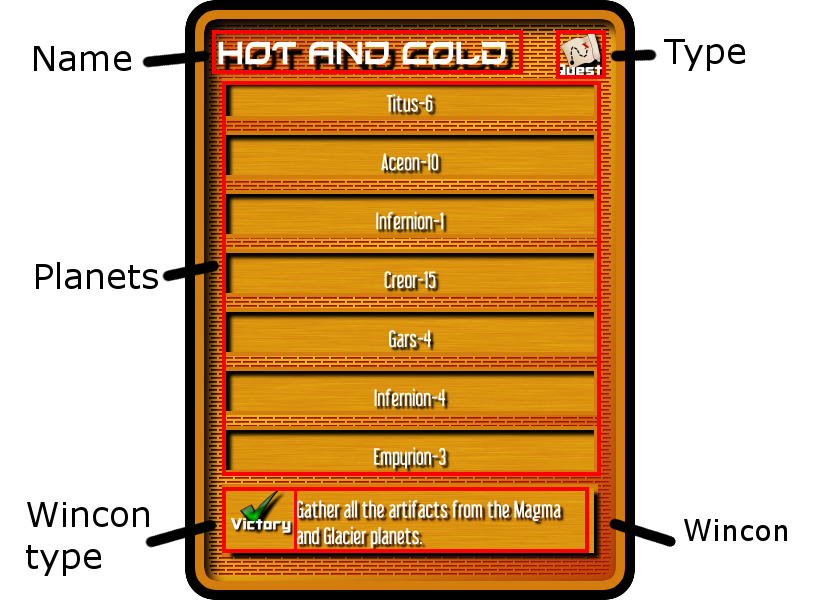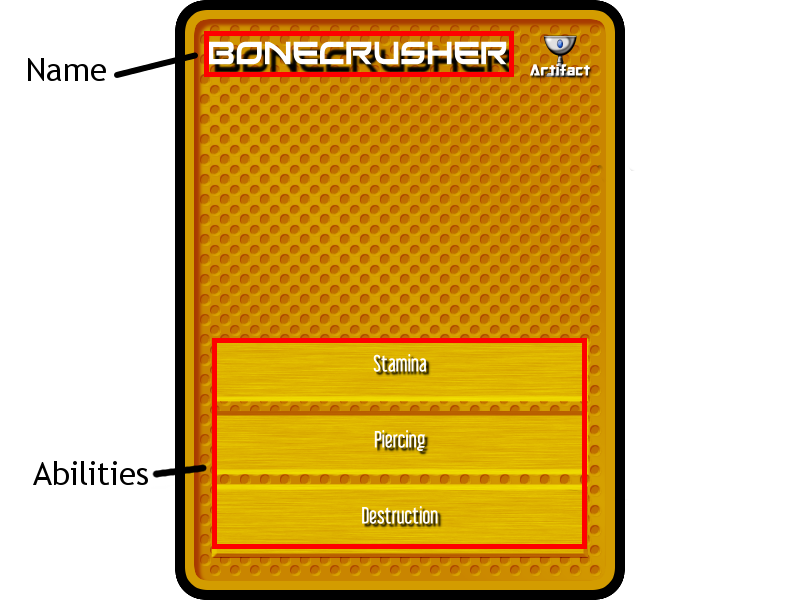Introduction
The main goal of The World Eater is to slay the man who summons the World Eater, known as the mastermind.
There are 7 types of cards: protagonists, antagonists, auxiliary, magic, quest, artifact, and planet (displayed left to right, up to down). Several have different layouts:

Protagonists are used to represent the components of the Astral Guard, and are recognizable by their dark gray background and usually have the Astral Guard symbol in the top right hand corner.
Antagonists represent the monsters that the protagonists might face on their journey, including The World Eater itself. They are recognizable by their fuschia background and usually have the Core symbol.
Auxiliaries represent the companions that the protagonists might encounter. They are recognizable by their lavender background and the Auxiliary symbol.

Magic is cast by protagonists and takes three different forms: Light, Dark, and Mental. They are recognizable by their light blue, dark blue, and white backgrounds and corresponding type icon.

Quests represent the progression of protagonists up until the final confrontation with the mastermind. They are recognizable by their orange background and Quest icon.



Artifacts represent the actual artifacts that protagonists find. They are recognizable by their orange-yellow background and Artifact icon.
Planets represent the physical planets from which characters interact. They are recognizable by their gray background and different icon representing each of the eight terrain types.
Attacks represent the combat options that are available to characters. They are recognizable by their dark red background and Attack icon.
Terminology
- Cycle - A card is cycled by shuffling it back into its respective deck, then drawing a new card. Whatever effects it has take effect, but in order to cycle Magic, more conditions might have to be met. (see Magic for more information.)
- Discard - A card is discarded by shuffling it back into its respective deck, then drawing a new card. It differs from cycling a card because its requirements do not have to be met, but its effects do not take effect either.
- Obstructed - A unit is obstructed when there is another unit or wall in front of it. Conversely, a unit is unobstructed when there are no units or walls in front of it.
- Play - A card is played by shuffling it back into its respective deck. A new card is not drawn.
Set-up
The game of The World Eater is fairly simple to set up.
- The mastermind draws a quest card. The quest card contains a list of planets, which are to be visited by the protagonists in order. The mastermind finds the planets in that quest and arranges them in order.
- The first planet has a size that corresponds to each "planet", or white box on the board. The planets are ordered based on their overall area: the largest white box represents a large planet and the smallest white box represents a small planet. They are also numbered based on their distance from the left side of the board.
- Each player chooses one or two unique protagonists from the 6 provided such that there are a total of 4 protagonists. Each protagonist has different stats and abilities, so it is best to choose protagonists that synergize well together. The players place their respective counters on the planet labeled 'S'.
- Each player, mastermind and otherwise, draws 2 attack cards each.
Taking Turns
Once the board is set up, each player takes their turn. The order does not matter as long as it stays consistent, so it may be decided by a dice roll, coin flip, or other arbitrary method. The turn proceeds as follows:
- Movement - Each protagonist may move up to 3 spaces, horizontally or vertically, and not through other units. The count starts on a space adjacent to the protagonist.
- Retreat - A protagonist may choose to retreat if they are adjacent to an antagonist. If a protagonist chooses to retreat, they flip a coin. If the flip is tails, then the antagonist they were retreating from may make deal 50% of its attack to the retreating protagonist. The protagonist may then move up to 3 extra spaces, but skips its combat phase.
- Combat - Each protagonist may choose to cycle or discard an attack or play a magic card. Except where noted, an attack must be cycled next to an antagonist, while a magic card may be played wherever. Protagonists may not attack on their first turn.
- Opening - A magic chest may be opened if a protagonist or auxiliary is on top of it. Only protagonists may open artifact chests.
A similar turn may be conducted for each auxiliary, conducted by the player whose character is closest at that time. The differences are that the auxiliary's attack stat is used for damage calculations, and artifacts found in chests are given to the nearest protagonist.
When at least one protagonist is at the edge of a planet, i.e. he cannot move any further in one direction, and all of the protagonists are adjacent to one another, then the entire group may choose to travel to a new planet. The protagonists must choose collectively whether they want to move to the next planet in the quest or the planet that is connected to the current planet via a path. Once they move to a new planet, arrange them as best as possible on the edge closest to the planet they were travelling from. Travelling uses up the rest of their movement for that turn. Whenever the protagonists move to a new planet, the summoning phase occurs:
- Summoning - The mastermind draws and reveals an auxiliary card. The players may decide if they want to summon the auxiliary, which may be done as long as the population cap is not breached in doing so. If the previous conditions are met, then the auxiliary is put into the auxiliary zone, from where their effects take place as if they were on the board.
Then, the mastermind's turn proceeds as follows:
- Movement - Each antagonist may move up to 3 spaces, horizontally or vertically, and not through other units. The mastermind may choose to travel to a different planet instead of moving, so long as he is on an edge of a planet. Unlike the protagonists, he may choose to move to any planet. Other antagonists must remain on the planet which they are summoned.
- Summoning - The mastermind may choose and summon an antagonist adjacent to him as long as the population cap is not breached.
- Combat - The mastermind may cycle an attack or magic card only if he has not summoned this turn. Each other antagonist may cycle an attack card.
- Opening - A magic chest may be opened if an antagonist is on top of it. Only the mastermind may open artifact chests.
The World Eater
Strangely enough, the World Eater doesn't exist in the game The World Eater as an actual character. This is because the very existence of The World Eater means the end of the universe. Thus, the World Eater itself, when summoned, is the win condition for the mastermind. Once the mastermind gathers 4 artifacts, he can begin summoning the World Eater. Summoning the World Eater takes 3 turns, during which the mastermind may not move, summon other units, or attack. Taking damage interrupts this summon, whereupon the mastermind must start the 3 turn summon again.
Population
The population cap is 20 for protagonists and 30 for antagonists. As mentioned above, once the population cap has been reached, that side may no longer summon.
Chests
| Chest | Type |
|---|---|
 |
Artifact Chest |
 |
Magic Chest |
Like the table suggests, there are two types of chests: artifact and magic. Artifact chests produce artifacts when opened and magic chests produce magic when opened. The artifact is the next unobtained artifact of the current planet, while the magic is simply drawn from the magic deck.
Magic
Some magic scales with the number of ether available. Any magic card may be played at the appropriate time, but some have additional effects. Each unit has a particular magic nature, such as light, dark, or mental and generate one ether of that type per turn. For example, Larond has a light magic nature, so he would generate one light ether per turn. Magic of an ether type scales with that ether type. If Larond wanted to play Burning Rage, which is dark magic, it would have no effect because he generates light ether. On the other hand, if he wanted to play Stitching Light, he could heal a unit for 200x1, because he has one light ether.
Artifacts
Artifacts are key in the fight against The World Eater. They each have up to 3 abilities. The first two abilities are active on the pre-boss stages. The last ability is active only on the boss stage and is called a Super Effect. Reference the google document on the Cards page to find out what each effect does.
Terrain
Units suffer the following penalties on terrain:
| Terrain | Effect |
|---|---|
| Omni | No effect |
| Desert | Units on desert take 50 more damage from attacks. |
| Gas | Units on gas have 100 less health. |
| Glacier | Magic cast on glacier costs 1 more ether. |
| Magma | Units on magma take 50 damage per turn. |
| Manmade | Predators on manmade move 1 less square per turn. |
| Ocean | An ocean tile consumes 2 movement points to move over. |
| Overgrown | Units on overgrown take double poison damage. |
Terrain abilities are used to represent the different strengths of units. They only activate on planets that match the ability. For example, Bone Sage has a glacier terrain ability, which it only has while on a glacier planet. Units with terrain abilities that match the terrain they are on ignore the penalties of that terrain. Bone Sage would be able to cast magic without the 1 ether penalty on glacier.
Death
Every protagonist might meet their end at one point, especially in the fight versus The World Eater. Unfortunately, death is hard to deal with. A unit is considered "dead" when its life is at or below 0. A protagonist who has died is moved to the dead area. He might be resurrected by the other Astral Guard members depending on the spells they get. An auxiliary who has died is returned to the auxiliary deck. An antagonist who has died is removed from play.
